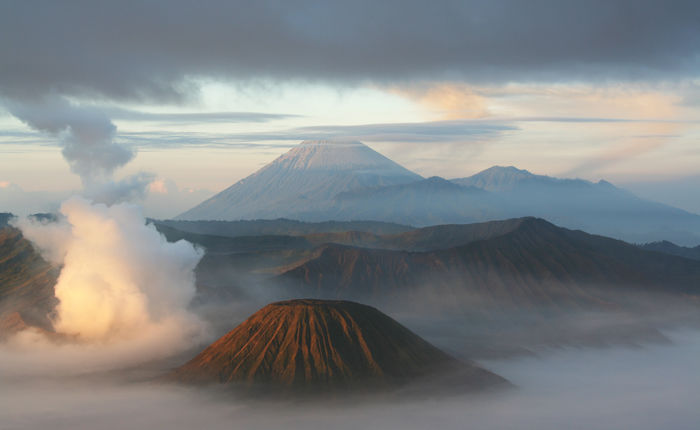What are the best things to see and do in the country?
The country is so vast and the attractions so diverse it is really difficult to sum up the highlights of the entire place into a few sentences. If you like beachy paradise destinations, Southern Bali, the Gili Islands (off northern Lombok), or the Banda Islands in Maluku will not disappoint. With 17,000 islands in the archipelago, it is very easy to find your very own desert island paradise. Adventurous mountaineers will appreciate the extensive volcanoes waiting to be scaled, everybody will appreciate the stunning volcanic setting of Gunung Bromo in Eastern Java. Temple lovers are able to see the largest Buddhist temple in the world at Borobodur and marvel at the spectacular views from the highest stupa. The country offers plenty of opportunities for getting away from it all; be it in a forested national park, on a deserted beach, on top of a mountain or in a remote Indonesian village. At the opposite end of the scale, the country also offers the height of luxury, tourism and nightlife. It is one country in the world where absolutely everyone can find something they like to see or do. Its only problem is its size, which prevents you from seeing it all. Plan your trip carefully around what you want to do most, and it definitely won't disappoint.
How long will I need to see most of the attractions?
To see even half of all the attractions in the country would probably take you several months. Unfortunately not all visitors have the luxury of so much time at their disposal. On a more limited time scale the main attractions on Java can be seen in about 2 weeks, Bali 2-3 weeks and Lombok 1-2 weeks. Obviously the longer you stay the more time you have to get off the beaten track and get out into rural Indonesia or explore the numerous national parks peppered across the Islands. These excursions can be the most rewarding, but can be time consuming and far from luxurious.
Where are the best beaches? Where has the best surf? What about diving/snorkelling?
One thing Indonesia has in abundance is beautiful deserted beaches. The degree of isolation and beauty varies from place to place, but none of the beaches (except possibly some of those in southern Bali) could ever be described as crowded. Wherever you are in the archipelago, stunning islands are never far away. Unfortunately many are so small than there is little or no infastructure for visiting them (save chartering a boat).
For those really looking to find islands all to themselves, head for either the Karimunjawa islands (north of Java) or the Banda islands in Maluku. Both these places offer completely untouristed beaches, where it is easily possible to find your own paradise. Appealing as this sounds, visitors should be aware that facilities in these islands are extremely limited. The few hotels that there are, are often left unstaffed as they have so few customers and restaurants are limited to one or two basic warung. Speaking at least a couple of words of Indonesian is pretty much essential here.
For those wanting beaches combined with all the comforts of home, the Gili Islands off Lombok will certainly not disappoint. The Gili's are a set of three white sand, coral fringed islands each with their own character. Facilities are greatest (and nightlife most hedonistic) on Gili Trawangan (although it is still a far cry from Kuta) and most peaceful on Gili Meno. These islands offer beautiful scenery, incredible snorkelling and diving, tasty food and lots of sunshine. It is this mixture that makes the Gili's one of the highlights of the archipelago.
For many visitors, surfing is one of Indonesia's best attractions. Surf sites are fairly prevalent around the country, particularly around Bali and Lombok. Main surfing areas are in: west Java, southern and eastern Bali, southern and western Lombok, and a few locations in southern Nusa Tenggara. If you wish to surf, it is probably best to bring your own board as hired boards tend to be fairly sub-standard. Surf is generally considered to be best in southern Bali in the Kuta region. This area is Indonesia's most touristy spot; expect plenty of westerners and aggressive touts.
Indonesia also offers some of the world's best diving and snorkelling. The archipelago offers 3 of the world's top 5 diving sites in the form of: The Banda islands, Alor in Nusa Tenggara and Pulau Bunaken in Sulawesi. Visibility is generally excellent, although it may be slightly lower during the wet season (October to April). Sites are abundant but equipment is not always readily available. Diving equipment is generally of a high standard but is not guaranteed to be so. Try to hire equipment from larger firms as these tend to be more reliable, but remember the responsibility of checking the equipment is ultimately yours.
If diving does not appeal, snorkelling sites are more accessible and equally abundant. Equipment is readily available, and the large majority of beach sites in (or off the coast of) Java, Bali, Lombok offer snorkelling and/or snorkelling trips (where you visit several different sites). The only place in these areas where snorkelling is more difficult is in the big surf destinations. Elsewhere coral, and a huge number (and vareity) of tropical fish will be teeming just below the surface of the water. Rays, giant turtles, and reef sharks all live in these areas and if you are lucky you may well get a glimpse of them.
Are there opportunities for good trekking?
Indonesia has almost limitless possibilities for trekking. The country offers a wide range of terrain and treks greatly differing in accessibility and difficulty. There are numerous vast national parks (Java alone has 7) which offer plenty of scope for exploration. Trails vary from clearly defined paths, through to almost invisible gaps in undergrowth. For the more challenging areas you may like to consider hiring a guide. Guides can be hired for a relatively expensive 100,000-200,000 Rp a day (around $11-$22), but their knowledge can be indispensable. In some national parks (e.g. The Komodo Island), you are forbidden from exploring without the aid of a guide. Hiking in Java, Bali and Lombok tends to be limited to volcanoes; the most popular being a 2-5 day hike up Gunung Rinjani in Lombok. These hikes are generally pretty exhausting, but the views at the end are well worth the struggle.
Remember at high altitudes, it gets very cold so pack plenty of warm clothing. Dress in several thin layers to help maintain body heat, and also help to adjust as the temperature rises on your descent. Do not underestimate how cold it gets up at high altitudes – people have died before by making that mistake.









Comments